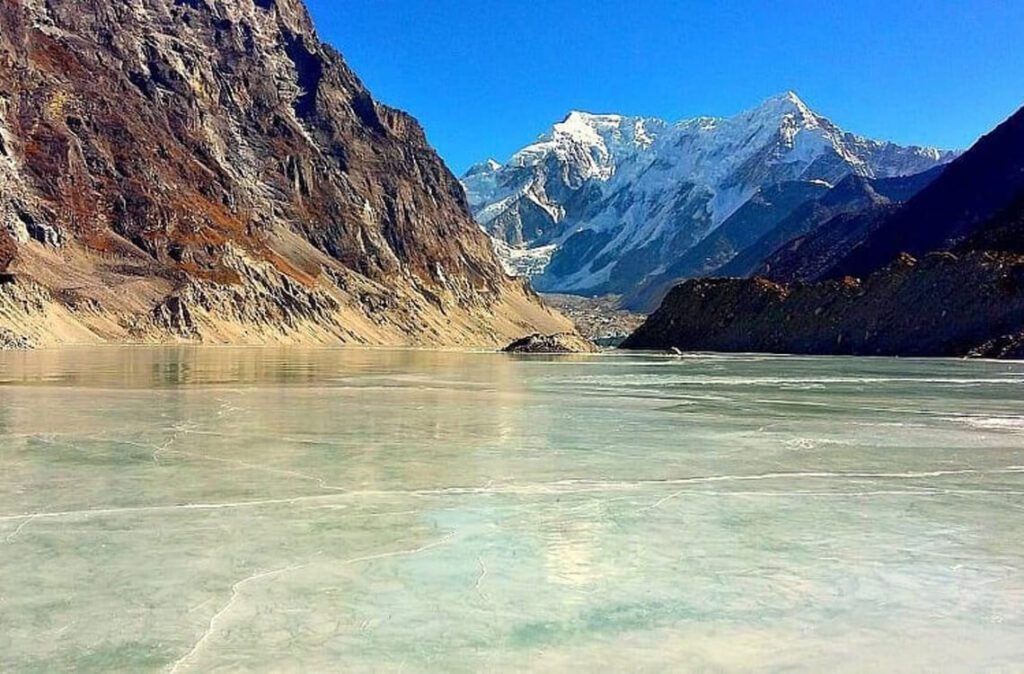Tsho Rolpa is the biggest glacial lake in Nepal. It is located in the Dolakha district of Nepal, and situated at an altitude of 4580 meters from the sea level. It covers an area of around 1.65 sq km. this lake remains a place of striking natural beauty, witness to the raw power and fineness of the Himalayan environment.
Tsho lies in the Gaurishankar conservation area which is a protected area in the Himalayas of Nepal that was established in January 2010, covering 2179 km2 in the Ramechhap, Dolakha, and Sinupalchwok district and surrounding 22 village development committees. In Sherpa language ‘Tsho’ means lake and ‘Rolpa’ means Rolwaling valley.
Surroundings of the Tsho Rolpa lake
The glacial lake is surrounded by bare hills and snow capped mountains which reflects on the surface of the lake make it breathtaking sight. The lake is situated high in the Rowaling valley, enclosed by towering peaks of the Himalayas. Rocky mountainsides and steep rocky ridges form the instant boundaries around the lake shoreline.
Also Read: Here is what you need to know about Imja Tsho Fastest Growing Lake in Nepal
The sky-blue water of the glacial lakes reflects the snowy mountains and makes the glaciers that loom above. The entire area of the lake’s surroundings is filled with lush green forests and mountains offering stunning views. Visitors can see the mountain views like Mt Gaurishankar, Pachermo Himal, Chobuste, Melungtse, and other Rowaling ranges.
Tsho Rolpa Lake trek
The trek is a popular trekking route in the Rolwaling valley of Dolakha district which is located in the central Himalayas. This is another valley of the Everest base camp trek. The trek takes travelers to beautiful Tsho Rolpa Lake. Tsho Rolpa Lake Trek is surrounded by towering mountains that offer breathtaking views of the surrounding landscapes.
The trek starts from Dolakha, near Charikot which takes 8 hours drive from Kathmandu. The trail moves along the Tama Koshi River for the most part of the trek and follows Rolwaling River. Travelers will travel through lush alpine forests, cross rushing streams, and pass through dense forests of pine and rhododendrons.

While traveling the landscapes become increasingly rough and dramatic. Towering snow-capped mountains of the range rise up on the side of the trail. And then the first glimpse of the wide Tsho Rolpa lake come into view.
You can see an unparalleled view of Tsho Rolpa, its sky-blue color waters stretching out against a backdrop of glacier-capped peaks.
Spending time at the lakeside allows trekkers to fully appreciate the immense scale and beauty of this high-altitude glacial lake. The sound of calving ice and rushing meltwater creates a serene, almost dreamy atmosphere.
Tsho Rolpa Trek offers opportunities to spot a variety of Himalayan wildlife, including Himalayan tahr, musk deer, and if one is extremely lucky, the elusive snow leopard.
This trek is considered as moderate to difficult trek and requires a good level of fitness and some trekking experience.
Experience Sherpa and Tamang villages
Along the trek, you will get the opportunity to experience the culture of the traditional Sherpa and Tamang villages. These villages will provide a glance into the unique culture, lifestyles, and traditions of the local communities.
You may also like: Sherpa People: Bravest Heroes of Mountain
Interact with the friendly locals, get to learn about their daily routine as and lifestyles, and have chances to got part in their warm hospitality. It’s an opportunity to grip yourself in the rich cultural heritage of the mountain region.
Flora and fauna
Alpine meadows surrounding the lake are carpeted with vibrant wildflowers during the brief summer, including primulas, gentians, anemones, and other hardy alpine species.
Scattered groves of coniferous trees like pine and fir cling to the rocky slopes, along with rhododendron shrubs. Hardy grasses and sedges are common ground cover in the high-altitude environment. Medicinal herbs and plants like Picrorhiza and cordyceps can also be found in the area.

Large mammal species include the Himalayan tahr, a nimble mountain goat, as well as the elusive musk deer. The endangered snow leopard, while rarely seen, prowls the rugged terrain in search of prey like the blue sheep. Other mammals like the Himalayan black bear, Himalayan serow, and Himalayan goral also inhabit the Rolwaling Valley.
Bird species include the colorful Himalayan monal pheasant, Tibetan snowcock, and various raptors like the golden eagle. Smaller creatures like the pika, Himalayan field mouse, and diverse insects and amphibians also thrive in the high-altitude ecosystem.
The best time to visit the lake
People used to visit the lake during the autumn and springs seasons when the weather is generally stable and clear where there is less chance of rainfall and snow.
More: Phewa Lake: Nepal’s Second Largest Freshwater Lake
The best time to visit the lake and to do a trek is from mid-March to May in the spring season and from September to November in the autumn season.
Let our expert team at Asian Heritage Treks and Travel take care of everything — from guided tours to personalized packing tips and travel arrangements.
Plan My Nepal Trip







